目录
- 前言
- 一、效果图
- 二、图层控制
- 三、指北针
- 四、folium添加js和css
- 五、经纬网格线
- 1.html页面实现经纬度网格
- 2.自定义网格线的类
- 3.实现网格线
前言
本博客重点:folium的使用功能,图层控制、指北针、folium添加js和css、经纬网格线(栅格线)
在上一篇使用folium制作地图的博客中,我们介绍了folium制作一张地图和基本使用,然而在使用中我们还需要一些额外的标识提升我们图片的质量,folium提供了更清晰的方法和插件,虽然官方插件很全,但是有时我们也需要自定义我们自己的插件。
我讲一下我这个需求的来源,做的项目是一个地理空间查询和使用的系统,通过在前端调用高德地图api创建了一个查询区域,获取区域内的地理数据(数据库)。具体的需求就是,将查询区域和地理数据制作成一个覆盖率分析报告,报告中的其他内容都已完成,但报告中需要展示高德地图、查询区域、地理数据的完整图片这个功能卡了2个星期,主要原因是我对地理空间数据不熟悉,很多python相关库也不清楚,在构建图形的过程中走了很多弯路。
现在将整个实现过程梳理完成,希望对各位同道有帮助,跟其他文章和官网不同,本博客是以使用的优先级来讲解这个库。
一、效果图
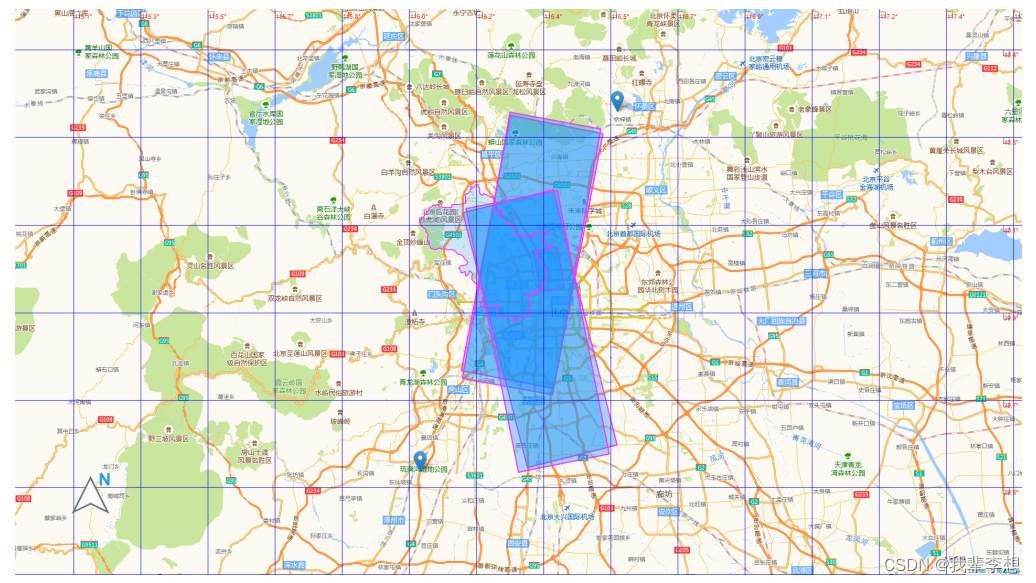
二、图层控制
上一篇博客讲的很基础,其实在folium官方还提供了一些更明确的方法供我们使用。就比如图层的控制。官方给方法名称是FeatureGroup,导入方式时from folium import FeatureGroup,或者folium.FeatureGroup()。具体原理我这里就不细说了,主要还是看示例:
| import folium | |
| def mappng(map_data,out_file='pdf.png'): | |
| #.直接构造,默认底图 | |
| mo = folium.Map(location=[, 0]) | |
| #.图层1-高德底图+数据 | |
| fg = folium.FeatureGroup() | |
| #.1 高德地图 | |
| fg.add_child(folium.TileLayer( | |
| tiles='http://webrd.is.autonavi.com/appmaptile?lang=zh_cn&size=1&scale=1&style=8&x={x}&y={y}&z={z}', | |
| attr="© <a href=http://ditu.amap.com/>高德地图</a>", | |
| min_zoom=, | |
| max_zoom=, | |
| control=True, | |
| zoom_control=False, | |
| show=True)) | |
| #.2添加一个点 | |
| fg.add_child(folium.Marker( | |
| location=[.3311, -121.7113], | |
| popup="Timberline Lodge", | |
| icon=folium.Icon(color="green"))) | |
| #.3添加一个线形 | |
| fg.add_child(folium.PolyLine( | |
| locations=[[.68,115.67], | |
| [.85,115.48], | |
| [.65,115.37], | |
| [.68,115.67]], | |
| color='green', weight=, opacity=1)) | |
| #.4添加一个面 | |
| fg.add_child(folium.Polygon( | |
| locations=[[.68,115.67], | |
| [.85,115.48], | |
| [.65,115.37], | |
| [.68,115.67]], | |
| color='green', weight=, | |
| fill=True,fill_color = 'red')) | |
| #.5将我们的图层加入map | |
| mo.add_child(fg) | |
| #.图层2-重点数据+最上层 | |
| fg = folium.FeatureGroup() | |
| fg.add_child(folium.Polygon( | |
| locations=[[.68,115.67], | |
| [.85,115.48], | |
| [.65,115.37], | |
| [.68,115.67]], | |
| color='green', weight=, | |
| fill=True,fill_color = 'red')) | |
| mo.add_child(fg) | |
| #.将图层fg2显示在最上层,keep_in_front的参数必须是FeatureGroup或TileLayer对象 | |
| mo.keep_in_front(fg) | |
| #.根据范围缩放地图 | |
| mo.fit_bounds([[.68,115.67], | |
| [.85,115.48], | |
| [.65,115.37], | |
| [.68,115.67]]) | |
| root = mo.get_root() | |
| html = root.render() # 这个拿到的就是一个html的内容 | |
| # mo.save('text.html') |
三、指北针
指北针这个功能对于地图来说不一定是必须的,但是加上总是好的。从官方和源码分析来看没有相关介绍,但是FloatImage放法可以完成这个功能。这个方法是官方文档中的插件,其实官方给了很多插件,网上使用最多的是热力图也就是HeatMap方法。
FloatImage方法实现的是将一张图片放到屏幕上,并指定图片的大小,和屏幕上的位置,参数为为整数(FloatImage方法实现了百分比转化)。我们在二代码的基础上,将图片加在了左下角。
fg.add_child(FloatImage(os.path.join(base, 'map_png', 'image', 'compass.png'), left=, bottom=10, width=5))
四、folium添加js和css
folium官方未提供添加js和css的相关方法,网上很多方法应该都是在解读源码的基础上进行的抽取,相对来说比较的单一,没有针对如何添加js和css进行相关说明。这里可以画一个folium里各种类的继承关系,方便我们更清晰的明白整个过程。
官方链接:https://www.osgeo.cn/folium/plugins.html

从源代码中可以知道,folium中实现地图功能是通过jinjia2实现数据和地图加载html的。
源码中主要使用了三种添加数据和地图的方法。这些方法存在缺陷(只能加在最前面),这些方法可以使用大多数场景,如果不涉及对map对象的操作,此三种方法可以满足要求。
1.header添加js和css
| init_script = """ | |
| var mapsPlaceholder = []; | |
| L.Map.addInitHook(function () {mapsPlaceholder.push(this);}); | |
| """ | |
| # 加在header最上边 | |
| mo.get_root().header.add_child(folium.Element(init_script)) |
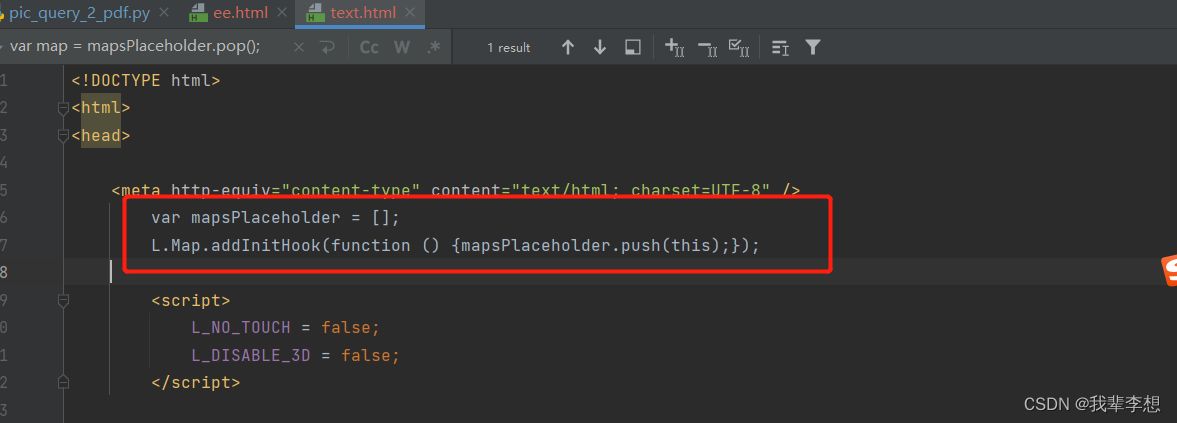
2.body添加js和css
| init_script = """ | |
| var mapsPlaceholder = []; | |
| L.Map.addInitHook(function () {mapsPlaceholder.push(this);}); | |
| """ | |
| # 加在body中 | |
| mo.get_root().html.add_child(folium.Element(init_script)) |
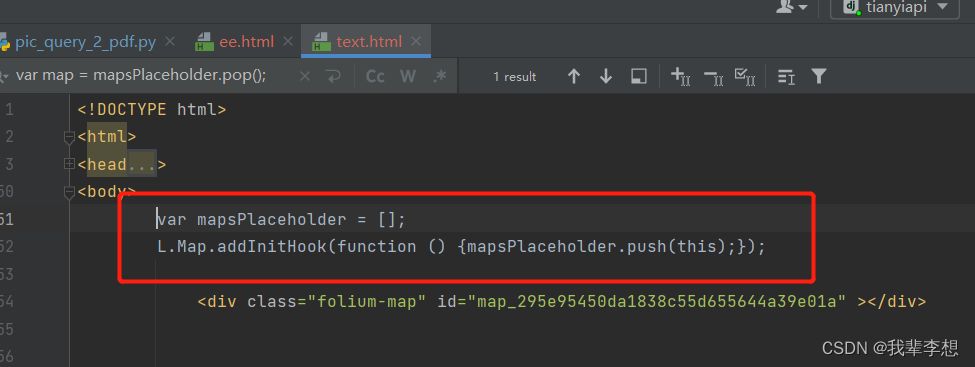
3.script添加js和css
| init_script = """ | |
| var mapsPlaceholder = []; | |
| L.Map.addInitHook(function () {mapsPlaceholder.push(this);}); | |
| """ | |
| # 加在script中 | |
| mo.get_root().script.add_child(folium.Element(init_script)) |
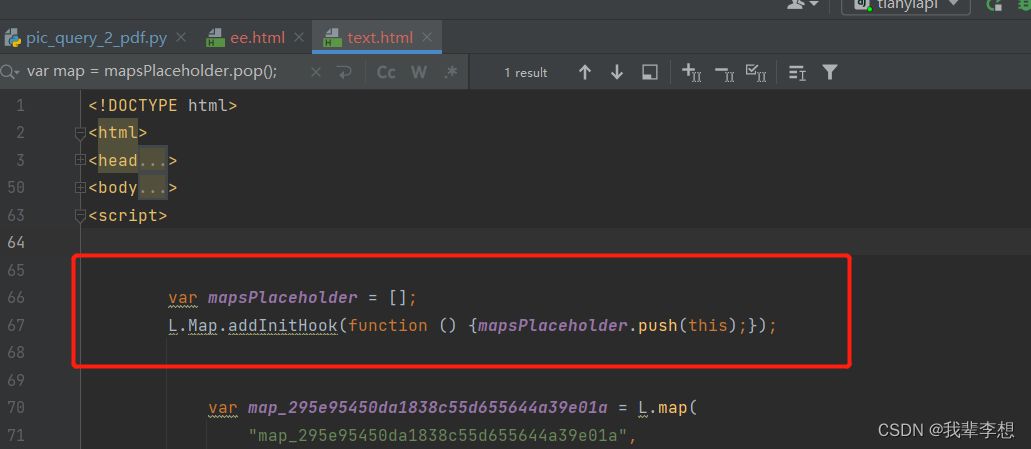
五、经纬网格线
上一步实现了在html文件不同位置添加js和css的方法,如果涉及到对map对象的操作,可能存在不满足的情况,比如添加经纬网格线。实现经纬网格线这个功能比较麻烦,主要存在以下困难:
1.官方没有相关的方法和插件(目前没有);
2.folium是依赖leadlet.js实现的第三方库,想实现经纬线需要熟悉leaflet(在网上只找到一篇相关文章);
3.上边的文章是前端完成,没有直接后端实现的方法。
4.前端实现的方法是直接构建的地图,我们这里是地图创建对象不可获取(地图对象随机生成)。
如何才能事项经纬网格线呢?
这里我们需要在map对象创建时将对象存储,在map对象创建后获取map对象并依据缩放实现网格线。这里有一个重点工作就是如何将js代码在map对象创建前后加入到html中。
其中map对象创建时将对象存储在四中已经实现,通过学习folium源码,重写了添加js的方法实现map对象创建后添加js。
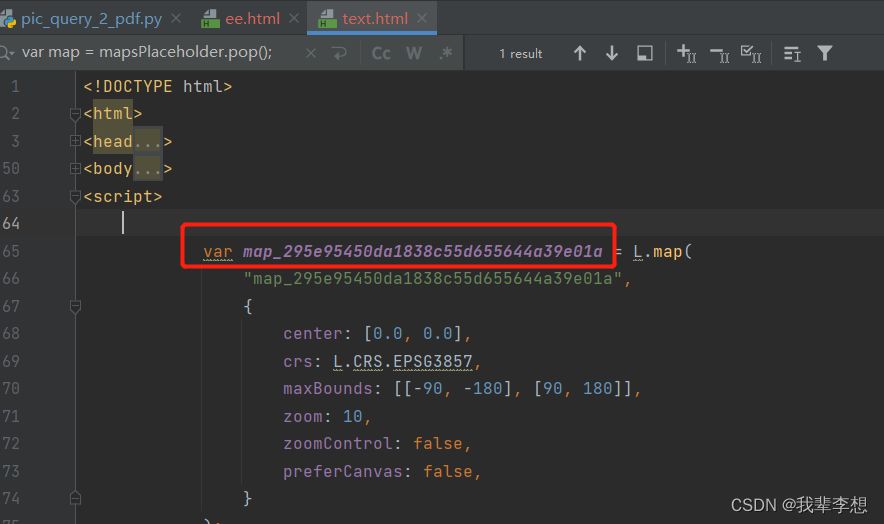
1.html页面实现经纬度网格
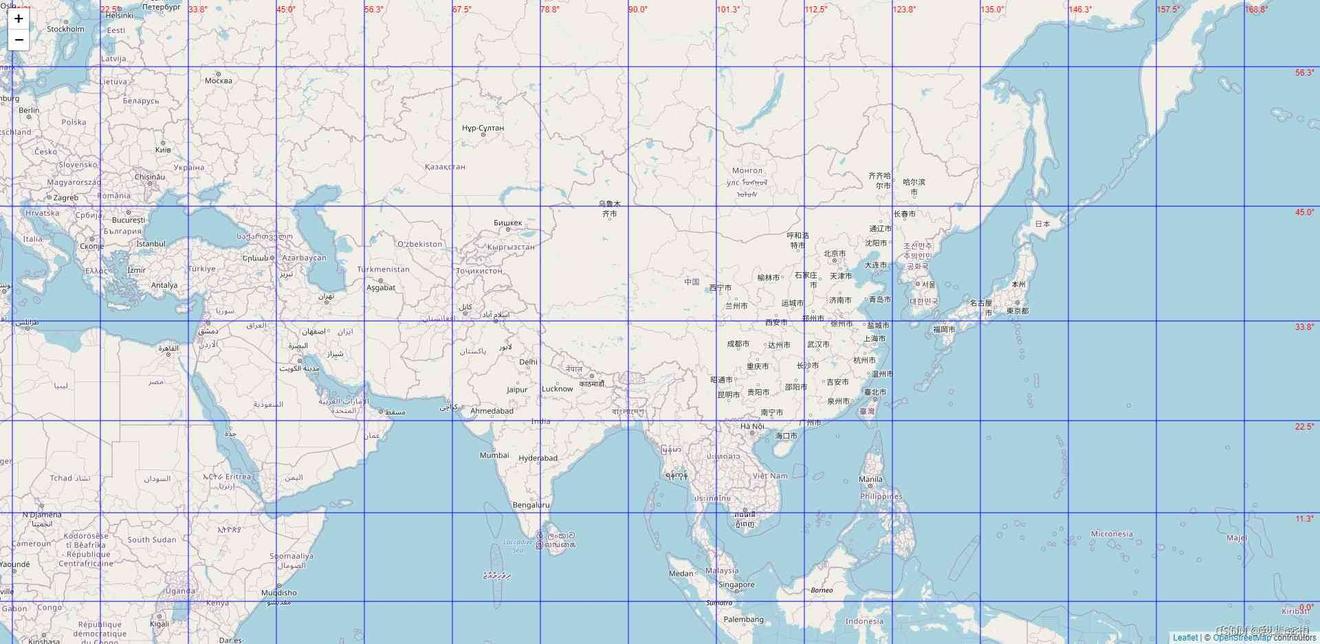
| <html lang="en"> | |
| <head> | |
| <meta charset="UTF-" /> | |
| <meta http-equiv="X-UA-Compatible" content="IE=edge" /> | |
| <meta name="viewport" content="width=device-width, initial-scale=.0" /> | |
| <link | |
| rel="stylesheet" | |
| href="https://unpkg.com/leaflet@.7.1/dist/leaflet.css" rel="external nofollow" | |
| /> | |
| <script src="https://unpkg.com/leaflet@.7.1/dist/leaflet.js"></script> | |
| <title>leaflet-经纬网格</title> | |
| <style> | |
| html, | |
| body { | |
| width:%; | |
| height:%; | |
| padding:; | |
| margin:; | |
| } | |
| .leaflet-div-icon { | |
| background: none; | |
| border: none; | |
| } | |
| </style> | |
| </head> | |
| <body> | |
| <div id="map" style="height:%; width: 100%"></div> | |
| <script> | |
| let map = L.map("map", { renderer: L.canvas({ padding:.5 }) }).setView( | |
| [.127879288597576, 118.37905883789064], | |
| ); | |
| // 添加背景图层 | |
| L.tileLayer("https://{s}.tile.openstreetmap.org/{z}/{x}/{y}.png", { | |
| attribution: | |
| '© <a href="https://www.openstreetmap.org/copyright" rel="external nofollow" >OpenStreetMap</a> contributors', | |
| }).addTo(map); | |
| // 创建图层 | |
| let lonLatGridLineLayer = L.featureGroup().addTo(map); | |
| // 经纬网格生成方法 | |
| let addLonLatLine = () => { | |
| let zoom = map.getZoom(); | |
| let bounds = map.getBounds(); | |
| let north = bounds.getNorth(); | |
| let east = bounds.getEast(); | |
| // 经纬度间隔 | |
| let d = / Math.pow(2, zoom - 1); | |
| // 经线网格 | |
| for (let index = -; index <= 360; index += d) { | |
| // 判断当前视野内 | |
| if (bounds.contains([north, index])) { | |
| // 绘制经线 | |
| let lonLine = L.polyline( | |
| [ | |
| [-, index], | |
| [, index], | |
| ], | |
| { weight:, color: "blue" } | |
| ); | |
| lonLatGridLineLayer.addLayer(lonLine); | |
| // 标注 | |
| let text = index.toFixed() + "°"; | |
| // 动态计算小数位数 | |
| if (zoom >) { | |
| text = index.toFixed((zoom -) / 2) + "°"; | |
| } | |
| let divIcon = L.divIcon({ | |
| html: `<div style="white-space: nowrap;color:red;">${text}</div>`, | |
| iconAnchor: [, -5], | |
| }); | |
| let textMarker = L.marker([north, index], { icon: divIcon }); | |
| lonLatGridLineLayer.addLayer(textMarker); | |
| } | |
| } | |
| if(d>)d=90; | |
| // 纬线网格 | |
| for (let index = -; index <= 90; index += d) { | |
| if (bounds.contains([index, east])) { | |
| let lonLine = L.polyline( | |
| [ | |
| [index, -], | |
| [index,], | |
| ], | |
| { weight:, color: "blue" } | |
| ); | |
| lonLatGridLineLayer.addLayer(lonLine); | |
| // 标注 | |
| let text = index.toFixed() + "°"; | |
| if (zoom >) { | |
| text = index.toFixed((zoom -) / 2) + "°"; | |
| } | |
| let divIcon = L.divIcon({ | |
| html: `<div style="white-space: nowrap;color:red;">${text}</div>`, | |
| iconAnchor: [(text.length +) * 6, 0], | |
| }); | |
| let textMarker = L.marker([index, east], { icon: divIcon }); | |
| lonLatGridLineLayer.addLayer(textMarker); | |
| } | |
| } | |
| }; | |
| addLonLatLine(); | |
| map.on("zoomend move", () => { | |
| lonLatGridLineLayer.clearLayers(); | |
| addLonLatLine(); | |
| }); | |
| </script> | |
| </body> | |
| </html> |
2.自定义网格线的类
通过源码的类继承关系,我采取继承MacroElement类。
| from branca.element import MacroElement, | |
| from jinja import Template | |
| from folium.vector_layers import path_options | |
| class Jwwg(MacroElement): | |
| """自定义经纬线网格""" | |
| _template = Template(""" | |
| {% macro script(this, kwargs) %} | |
| var map = mapsPlaceholder.pop(); | |
| // 创建图层 | |
| let lonLatGridLineLayer = L.featureGroup().addTo(map); | |
| // 经纬网格生成方法 | |
| let addLonLatLine = () => { | |
| let zoom = map.getZoom(); | |
| let bounds = map.getBounds(); | |
| let north = bounds.getNorth(); | |
| let east = bounds.getEast(); | |
| // 经纬度间隔 | |
| let d = / Math.pow(2, zoom - 1); | |
| // 经线网格 | |
| for (let index = -; index <= 360; index += d) { | |
| // 判断当前视野内 | |
| if (bounds.contains([north, index])) { | |
| // 绘制经线 | |
| let lonLine = L.polyline( | |
| [ | |
| [-, index], | |
| [, index], | |
| ], | |
| {weight:, color: "blue"} | |
| ); | |
| lonLatGridLineLayer.addLayer(lonLine); | |
| // 标注 | |
| let text = index.toFixed() + "°"; | |
| // 动态计算小数位数 | |
| if (zoom >) { | |
| text = index.toFixed((zoom -) / 2) + "°"; | |
| } | |
| let divIcon = L.divIcon({ | |
| html: `<div style="white-space: nowrap;color:red;">${text}</div>`, | |
| iconAnchor: [, -5], | |
| }); | |
| let textMarker = L.marker([north, index], {icon: divIcon}); | |
| lonLatGridLineLayer.addLayer(textMarker); | |
| } | |
| } | |
| if (d >) d = 90; | |
| // 纬线网格 | |
| for (let index = -; index <= 90; index += d) { | |
| if (bounds.contains([index, east])) { | |
| let lonLine = L.polyline( | |
| [ | |
| [index, -], | |
| [index,], | |
| ], | |
| {weight:, color: "blue"} | |
| ); | |
| lonLatGridLineLayer.addLayer(lonLine); | |
| // 标注 | |
| let text = index.toFixed() + "°"; | |
| if (zoom >) { | |
| text = index.toFixed((zoom -) / 2) + "°"; | |
| } | |
| let divIcon = L.divIcon({ | |
| html: `<div style="white-space: nowrap;color:red;">${text}</div>`, | |
| iconAnchor: [(text.length +) * 6, 0], | |
| }); | |
| let textMarker = L.marker([index, east], {icon: divIcon}); | |
| lonLatGridLineLayer.addLayer(textMarker); | |
| } | |
| } | |
| }; | |
| addLonLatLine(); | |
| map.on("zoomend move", () => { | |
| lonLatGridLineLayer.clearLayers(); | |
| addLonLatLine(); | |
| }); | |
| {% endmacro %} | |
| """) | |
| def __init__(self, **kwargs): | |
| super(Jwwg, self).__init__() | |
| self._name = 'Jwwg' | |
| self.options = path_options(line=True, **kwargs) |
3.实现网格线
| import folium | |
| def mappng(map_data,out_file='pdf.png'): | |
| #.直接构造,默认底图 | |
| mo = folium.Map(location=[, 0]) | |
| #.图层1-高德底图+数据 | |
| fg = folium.FeatureGroup() | |
| #.1 高德地图 | |
| fg.add_child(folium.TileLayer( | |
| tiles='http://webrd.is.autonavi.com/appmaptile?lang=zh_cn&size=1&scale=1&style=8&x={x}&y={y}&z={z}', | |
| attr="© <a href=http://ditu.amap.com/>高德地图</a>", | |
| min_zoom=, | |
| max_zoom=, | |
| control=True, | |
| zoom_control=False, | |
| show=True)) | |
| #.2添加一个点 | |
| fg.add_child(folium.Marker( | |
| location=[.3311, -121.7113], | |
| popup="Timberline Lodge", | |
| icon=folium.Icon(color="green"))) | |
| #.3添加一个线形 | |
| fg.add_child(folium.PolyLine( | |
| locations=[[.68,115.67], | |
| [.85,115.48], | |
| [.65,115.37], | |
| [.68,115.67]], | |
| color='green', weight=, opacity=1)) | |
| #.4添加一个面 | |
| fg.add_child(folium.Polygon( | |
| locations=[[.68,115.67], | |
| [.85,115.48], | |
| [.65,115.37], | |
| [.68,115.67]], | |
| color='green', weight=, | |
| fill=True,fill_color = 'red')) | |
| #.5将我们的图层加入map | |
| mo.add_child(fg) | |
| #.根据范围缩放地图 | |
| mo.fit_bounds([[.68,115.67], | |
| [.85,115.48], | |
| [.65,115.37], | |
| [.68,115.67]]) | |
| # 网格线 | |
| init_script = """ | |
| var mapsPlaceholder = []; | |
| L.Map.addInitHook(function () {mapsPlaceholder.push(this);}); | |
| """ | |
| mo.get_root().script.add_child(folium.Element(init_script)) | |
| Jwwg().add_to(mo) | |
| root = mo.get_root() | |
| html = root.render() # 这个拿到的就是一个html的内容 | |
| # mo.save('text.html') |